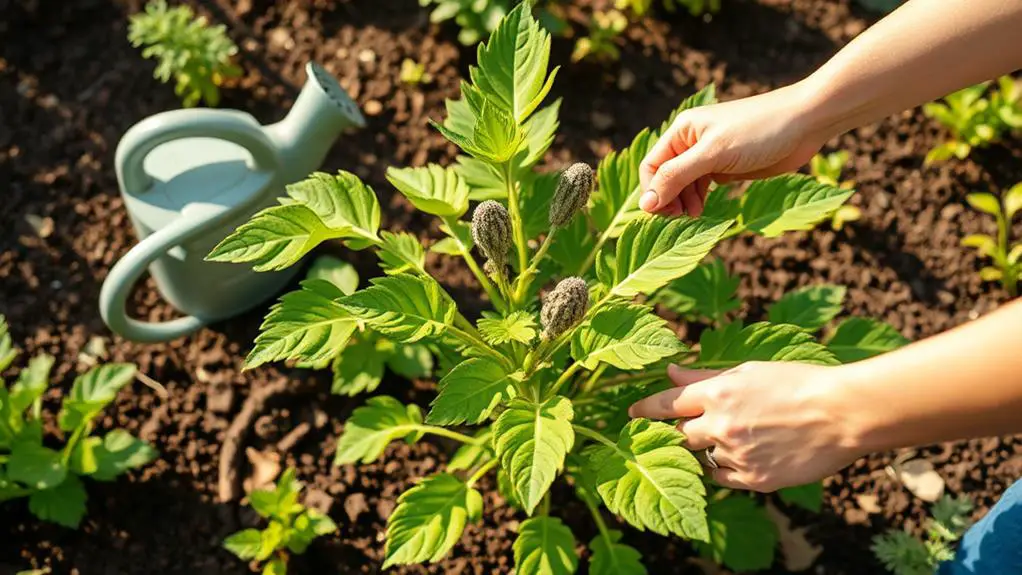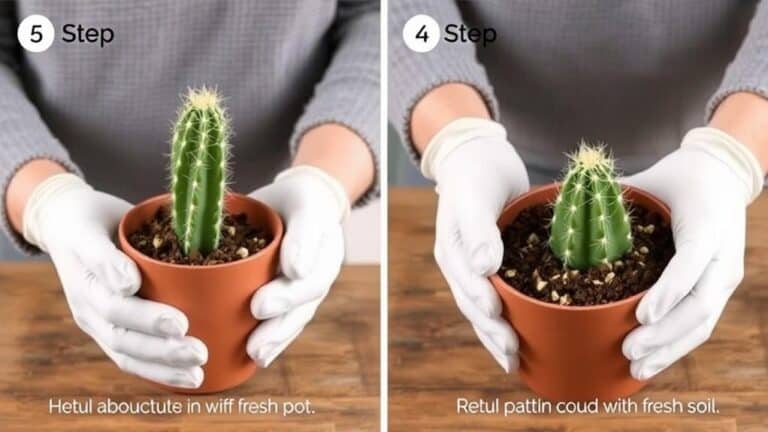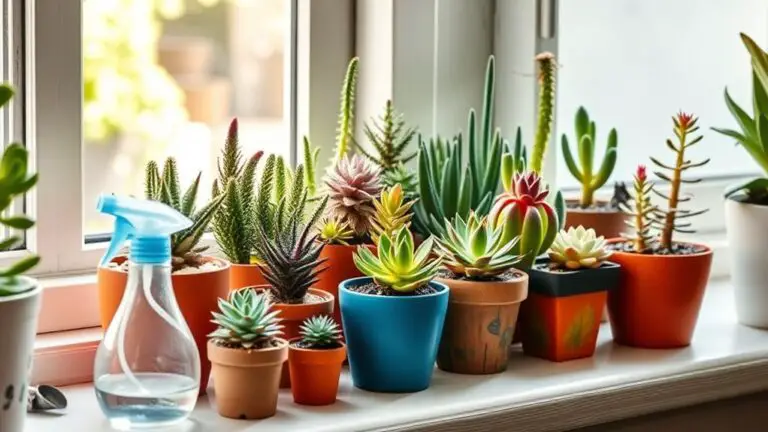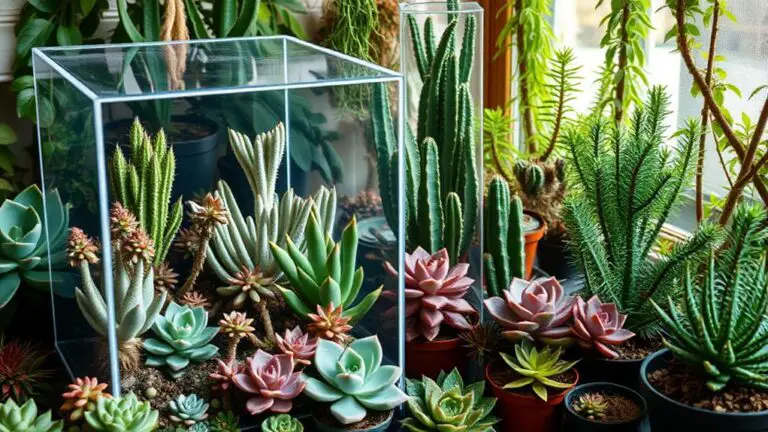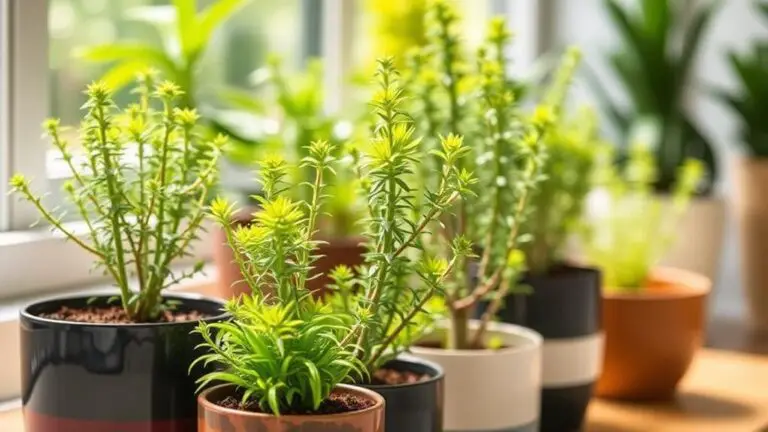7 Essential Steps to Grow a Healthy Cocoon Plant Senecio
If you're looking to grow a healthy Cocoon Plant (Senecio), there are seven essential steps you can follow to guarantee success. Start with selecting well-draining soil and pots with drainage holes to prevent root rot. Watering correctly is vital; you'll need to let the soil dry completely between sessions. Morning sunlight is best, and you should aim for 4 to 6 hours daily. Maintaining the right temperature and humidity, fertilizing annually, and using the right propagation methods are all important. Finally, keeping an eye out for pests and diseases can make all the difference. But how do you implement these steps effectively?
Choose the Right Soil
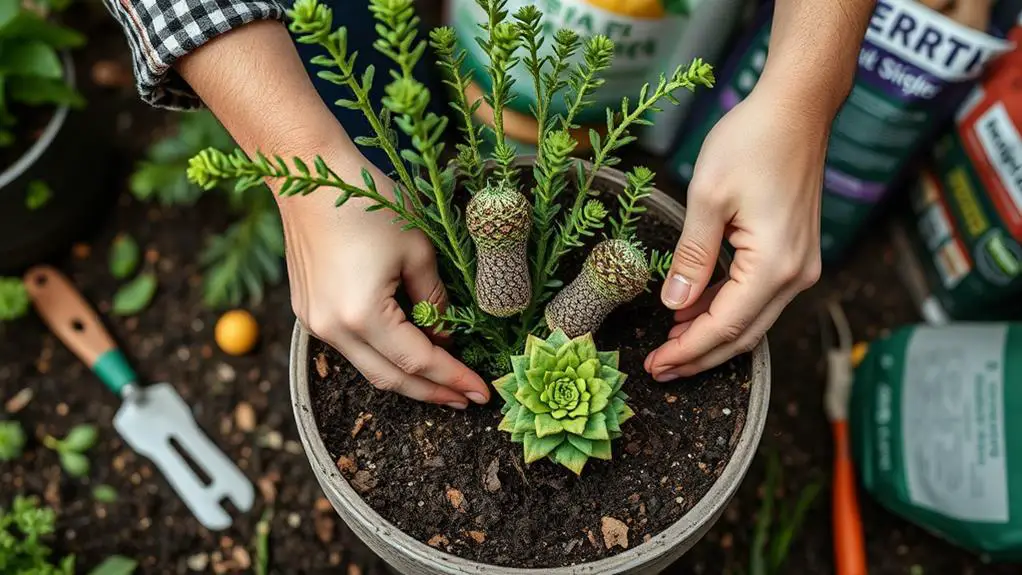
Wondering how to assure your Cocoon Plant thrives? The secret lies in choosing the right soil. To prevent root rot, you'll need well-draining soil, like a cactus or succulent mix. This special soil guarantees your plant's roots don't sit in water for too long, which can be harmful.
A good mix for your Cocoon Plant is 50% organic matter and 50% inorganic matter. This combination provides excellent aeration and drainage, keeping the roots healthy. You can make a DIY gritty soil at home by mixing potting soil with perlite or pumice. These materials help create the perfect environment for your plant to grow strong and vibrant.
Always place your Cocoon Plant in pots with drainage holes. These holes allow excess water to escape, preventing the soil from becoming too wet.
It's also important to regularly check the soil moisture. Make sure it dries out completely between watering sessions. This practice helps avoid prolonged wet conditions that can cause root rot.
Proper Watering Techniques
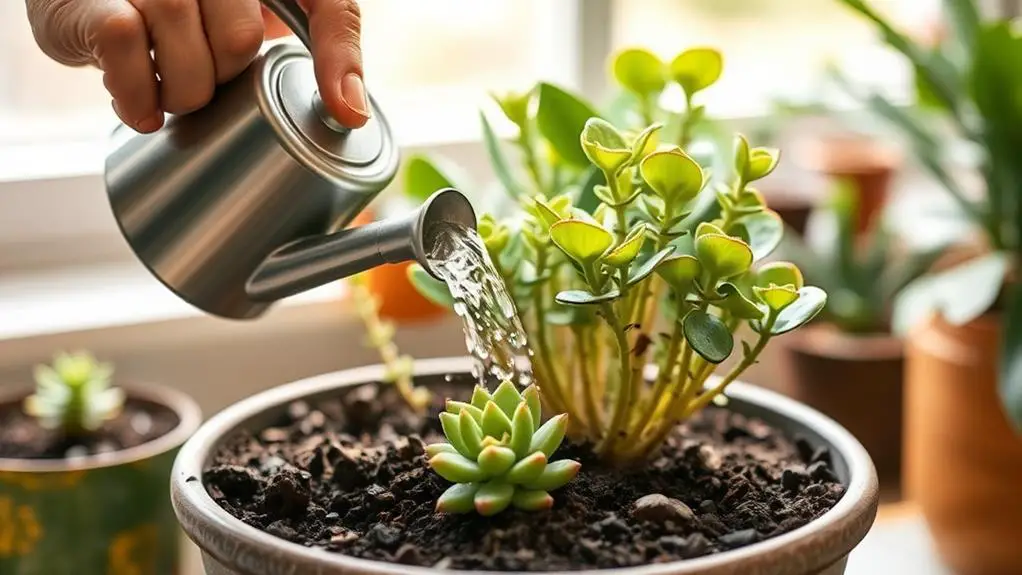
Proper watering techniques are essential for keeping your Cocoon Plant healthy and vibrant. To start, you need to water your Cocoon Plant thoroughly but carefully to avoid common issues like leggy stems and root rot.
Stick your finger into the soil to check its moisture level. Only water when the soil is completely dry. This helps to prevent overwatering, which can damage your plant.
When you water, make sure to drench the soil fully. However, be cautious not to let water sit in the pot. Your pots should have drainage holes to let excess water escape, keeping the soil mix well-aerated and healthy.
During the summer, you should water about once a week, but in winter, reduce it to once a month. This change in frequency aligns with the plant's natural growth cycles.
Keep an eye on the leaves for signs of distress. Droopy and shriveled leaves mean your plant needs water, while firm leaves indicate it's fine for now.
Sunlight Requirements

To keep your Cocoon Plant healthy, make sure it gets 4 to 6 hours of full morning sunlight each day.
If you're growing it indoors, place it near a south or west-facing window to give it the light it needs.
If natural sunlight isn't enough, you can use artificial grow lights to keep your plant happy and thriving.
Optimal Morning Sunlight
Guaranteeing your Cocoon Plant gets 4 to 6 hours of full morning sunlight daily is vital for its ideal growth. Proper light exposure is significant to keep your plant healthy and thriving.
Positioning it near a south or west-facing window will help you achieve this best morning sunlight. If your plant doesn't get enough light, it might become leggy, meaning it will stretch out trying to find more light.
Here are some tips to guarantee your Cocoon Plant gets the right amount of sunlight:
- South or West Window: Place your plant near these windows to get the best full sun exposure in the morning.
- Monitor Growth: Watch for signs of insufficient light, like leggy growth, and adjust its position as needed.
- Outdoor Placement: If you're growing your plant outside, make sure it gets bright morning light and some afternoon shade to prevent leaf scorch.
- Use Grow Lights: During shorter winter days, artificial grow lights can help supplement natural light.
- Regular Adjustment: Rotate your plant occasionally to guarantee even light distribution.
Indoor Light Placement
Indoor light placement plays a pivotal role in maintaining the health and vibrancy of your Cocoon Plant. To guarantee it thrives, you'll need to provide 4 to 6 hours of full morning sunlight daily. The best spot for this is near a south or west-facing window, where the plant can soak up those essential rays. This setup helps prevent leggy growth and keeps your Cocoon Plant looking its best.
If your home doesn't get enough natural light, don't worry. You can use artificial grow lights to supplement the sunlight. Place these lights close to the plant to guarantee it gets adequate sunlight exposure.
Remember, without enough light, your Cocoon Plant may develop elongated stems, making it look less vibrant and healthy.
Regularly check on your plant's growth. If you notice it becoming leggy or less vigorous, it might be a sign that it needs more light. Adjust its placement or increase the time under artificial grow lights.
Ideal Temperature and Humidity
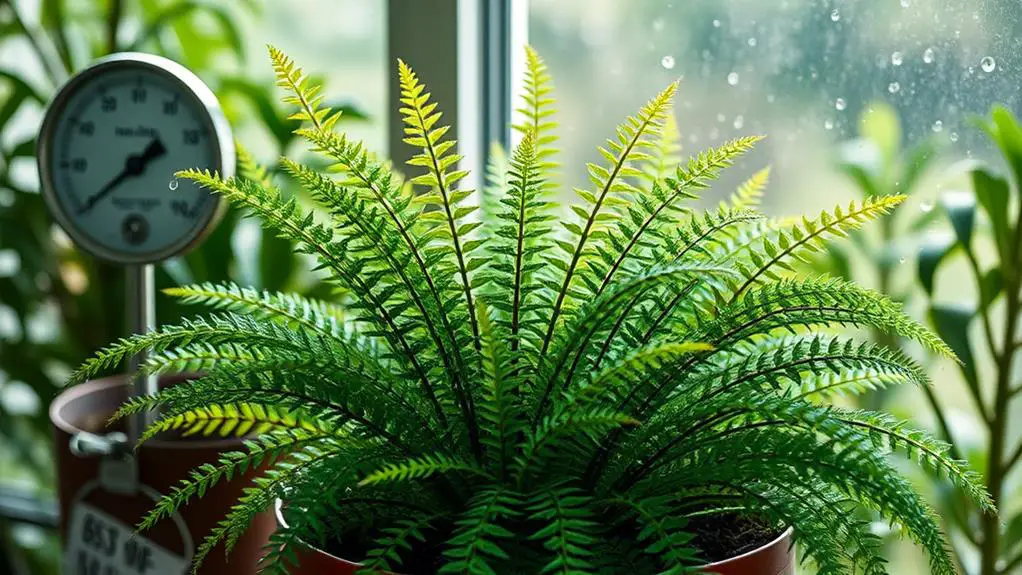
The Cocoon Plant, also known as Senecio, flourishes best in temperatures ranging from 25°F to 30°F (-6°C to -1°C) and needs protection from frost to survive in colder climates.
It's important to maintain these temperatures, especially during winter months when the plant goes dormant. In this period, lower temperatures and reduced watering are significant to prevent overwatering.
To guarantee your Cocoon Plant thrives, pay attention to its ideal humidity needs. Moderate humidity levels are best, as too much moisture can lead to fungal issues, particularly if the plant is overwatered.
Good air circulation around the plant is also key, as it helps maintain healthy humidity levels and reduces the risk of pests.
- Avoid overwatering: Too much water can harm your drought-tolerant Cocoon Plant.
- Guarantee moderate humidity: Too much humidity can cause fungal problems.
- Provide good air circulation: This helps keep humidity in check and wards off pests.
- Protect from frost: Keep your plant safe when temperatures drop.
- Adjust watering in winter: Reduce watering when the plant is dormant to avoid root rot.
Fertilization Practices
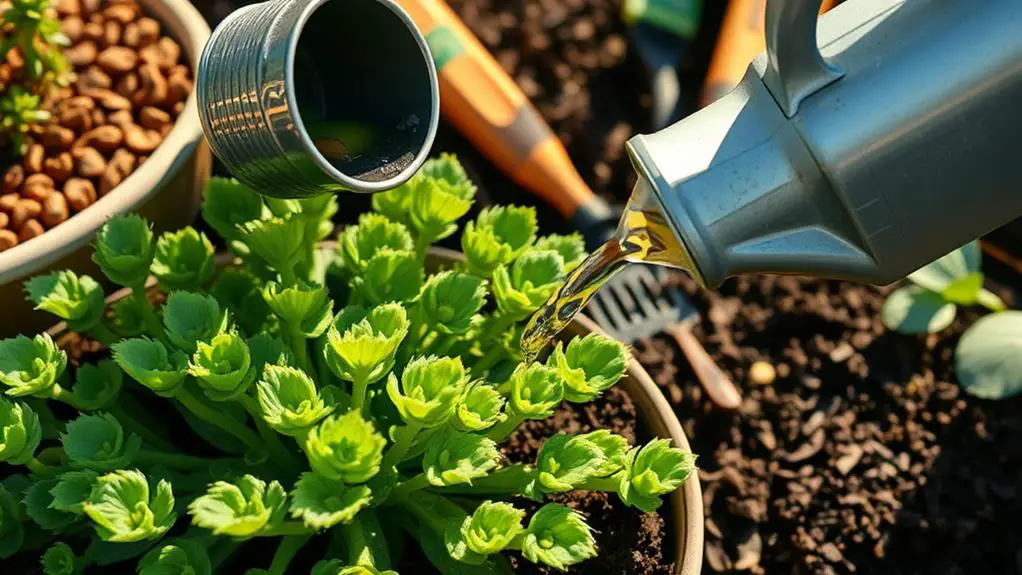
Fertilizing your Cocoon Plant properly is key to its healthy growth and vibrant appearance. For the best results, fertilize once annually during its active growth period in spring.
Use a diluted succulent fertilizer to promote healthy growth. If you don't have a succulent-specific fertilizer, a regular water-soluble one will do, but make sure to dilute it by at least 50%. This prevents burning the plant, which can happen if the fertilizer is too strong.
You can also use homemade fertilizers like banana peels or coffee grounds. These natural options provide essential nutrients and are great for plant care.
Another fantastic alternative is fish tank water. It's a natural fertilizer that enriches the soil without the risk of chemical damage.
Remember, avoid fertilizing during the dormant winter months. During this time, the Cocoon Plant requires minimal nutrients, so adding fertilizer could do more harm than good.
Stick to fertilizing in the spring to keep your succulent healthy.
Propagation Methods
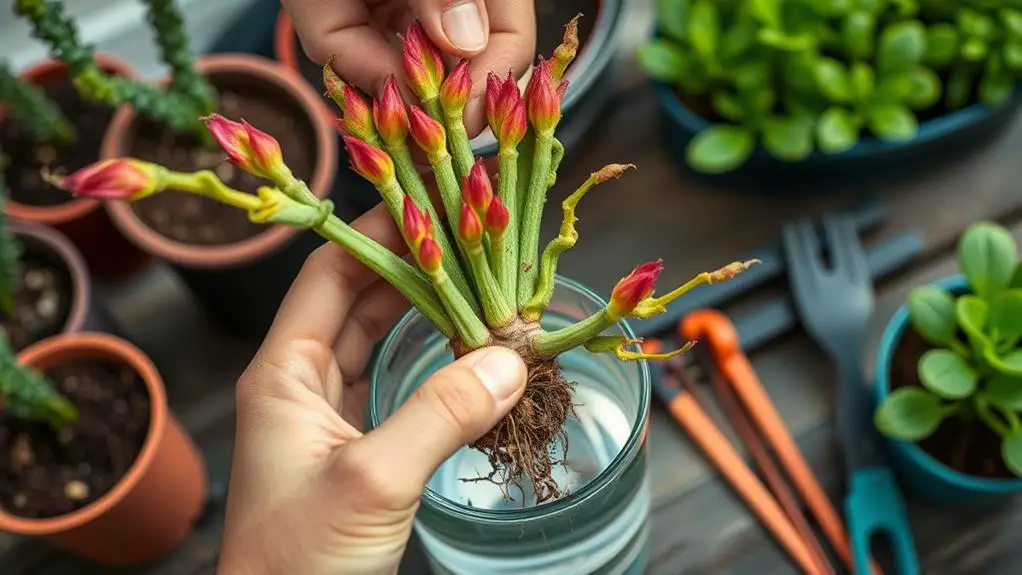
When you're ready to propagate your Cocoon Plant, using stem cuttings is the way to go.
Make certain you use clean, sharp tools to take the cuttings, and let them callous for a few days before planting in well-draining soil.
This method helps guarantee your new plants root well and thrive just like the mother plant.
Leaf Cutting Propagation
Leaf cutting propagation for the Cocoon Plant, also known as Senecio, can be a rewarding method for expanding your plant collection. Start by using clean, sharp tools to remove a healthy leaf from the mother plant. This guarantees that your cutting is in the best condition for rooting.
Next, let the cuttings callous for several days in a dry, shaded area. This step is vital to prevent rot and promote successful rooting.
Once calloused, plant the leaf cuttings in well-draining soil. The soil type is important to avoid overwatering, which can be harmful.
Water the cuttings sparingly, only when the soil is completely dry. This encourages root development without the risk of overwatering. Remember, too much water can cause the cuttings to rot.
Verify that each cutting has at least two leaves. This increases the chances of successful propagation and growth.
Monitor the cuttings for signs of new growth. New growth indicates that the cuttings have successfully rooted and are adapting to their new environment.
- Use clean, sharp tools to remove a leaf.
- Allow cuttings to callous in a dry, shaded area.
- Plant in well-draining soil.
- Water sparingly when soil is dry.
- Verify cuttings have at least two leaves.
Stem Cutting Techniques
Stem cutting propagation for the Cocoon Plant, also known as Senecio haworthii, is a straightforward and efficient method to expand your collection.
Start by using clean, sharp tools to take stem cuttings from a healthy plant. Each cutting should include at least two leaves. This will give them the best chance to grow. Make sure the tools are sanitized to prevent any infections.
Once you've got your stem cuttings, place them in a dry environment for a few days. This helps them callous over, which is important before planting.
When you're ready to plant, use well-draining soil. This type of soil keeps the cuttings from sitting in water, reducing the risk of rot.
After planting, water the cuttings only when the soil is completely dry. This encourages root growth.
Place your cuttings in a spot with bright indirect sunlight. They need light but can be sensitive to direct sun at this stage.
Keep an eye out for new growth, which indicates that your cuttings have successfully rooted and are turning into new plants.
Follow these steps, and you'll soon have a thriving collection of Cocoon Plants!
Callousing Before Planting
Allowing your Cocoon Plant cuttings to callous before planting is an essential step in the propagation process. This helps prevent rot and encourages healthy root development.
After you've removed cuttings from the mother plant, let them sit in a dry, shaded area with good air circulation. This environment promotes the formation of a protective layer over the cut ends.
Here's a quick guide to guarantee successful callousing:
- Duration: Allow your cuttings to callous for about 3 to 7 days, depending on the humidity and temperature.
- Leaf Count: Verify each cutting has at least two leaves, which will boost the chances of successful rooting.
- Environment: Place your cuttings in a dry, shaded spot with good air flow to help the cut ends heal.
- Check: Look for a dried, slightly shriveled appearance at the cut ends to know they're ready.
- Soil: After callousing, plant the cuttings in well-draining soil, and wait until the soil is completely dry before watering to encourage root development.
Pest and Disease Management
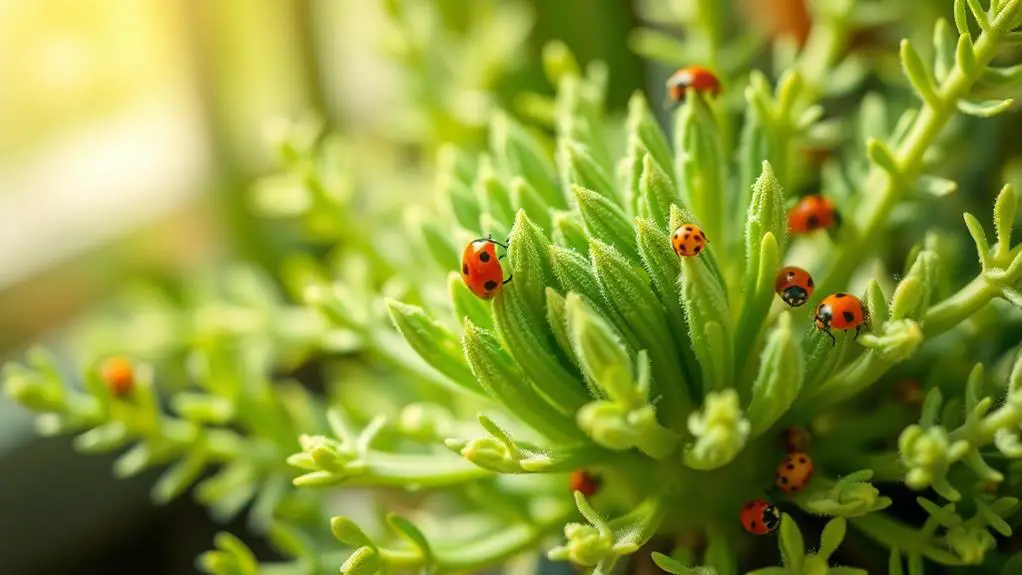
Regularly inspecting your Cocoon Plant for common pests like mealybugs and aphids is essential, as these invaders can weaken the plant and stunt its growth.
These pests can be sneaky, so check the leaves and stems closely. If you spot any, treat them right away with insecticidal soap or neem oil to minimize damage and restore plant health.
Good air circulation around your Cocoon Plant is imperative to prevent fungal diseases, which are often made worse by overwatering.
Make sure the plant has plenty of space to breathe. Overwatering can lead to root rot, so monitor your watering habits carefully. Look out for signs like leaf discoloration or drooping, which could indicate too much water.
Another important step is to remove any dead or decaying leaves from the plant.
This limits the potential for pests and diseases to take hold, keeping your plant vibrant and healthy. Regular pruning not only tidies up the plant but also promotes overall well-being.
Frequently Asked Questions
How Do You Take Care of a Cocoon Plant?
Water your Cocoon Plant weekly in summer, letting soil dry between waterings. In winter, water monthly. Use well-draining soil, place it in bright morning sunlight, fertilize in spring, and check for pests to keep it healthy.
How to Care for a Senecio Plant?
Place your Senecio plant in a spot with 4-6 hours of morning sunlight. Water weekly in summer, monthly in winter. Use well-draining soil, fertilize sparingly in spring, and watch for pests, treating them promptly.
Why Is My Cocoon Plant Shriveling?
Your cocoon plant's shriveling likely indicates underwatering. Check the soil; if it's dry, water thoroughly. Guarantee a consistent watering schedule once the soil is dry. Also, avoid excessive heat and provide partial shade during the hottest times.
Why Is My Cocoon Plant Turning Brown?
Your cocoon plant's browning could be due to overwatering, underwatering, or too much direct sunlight. Check the soil's moisture, adjust your watering habits, and guarantee it gets 4 to 6 hours of morning sunlight with some afternoon shade.
Conclusion
You've got all the steps needed to grow a healthy Cocoon Plant (Senecio). By choosing the right soil, watering correctly, and giving it enough sunlight, your plant will thrive. Remember to keep the temperature just right, fertilize in the spring, and use cuttings to propagate more plants. Don't forget to watch out for pests and diseases. Follow these tips, and you'll enjoy a beautiful, healthy plant in no time! Happy gardening!

